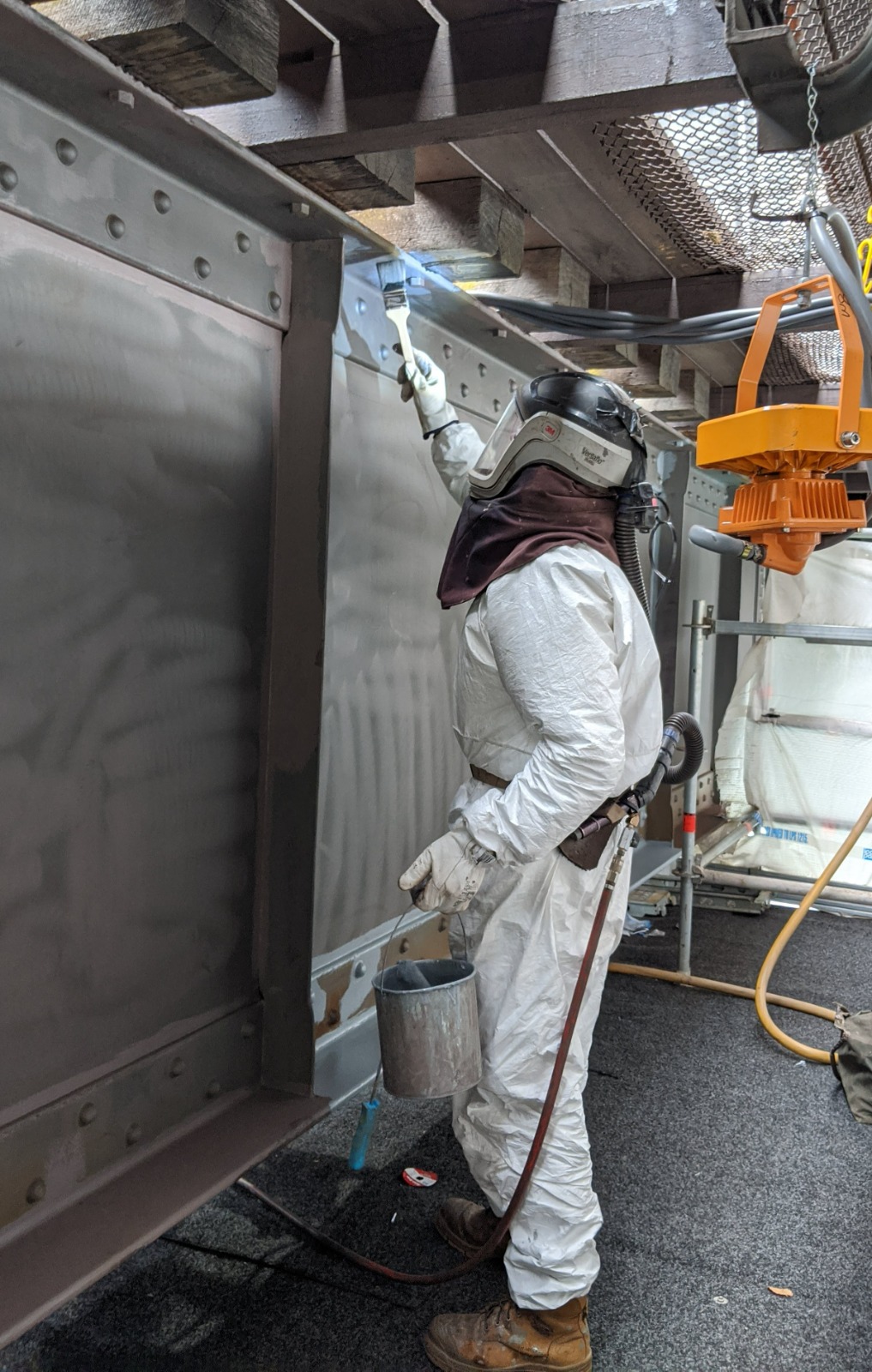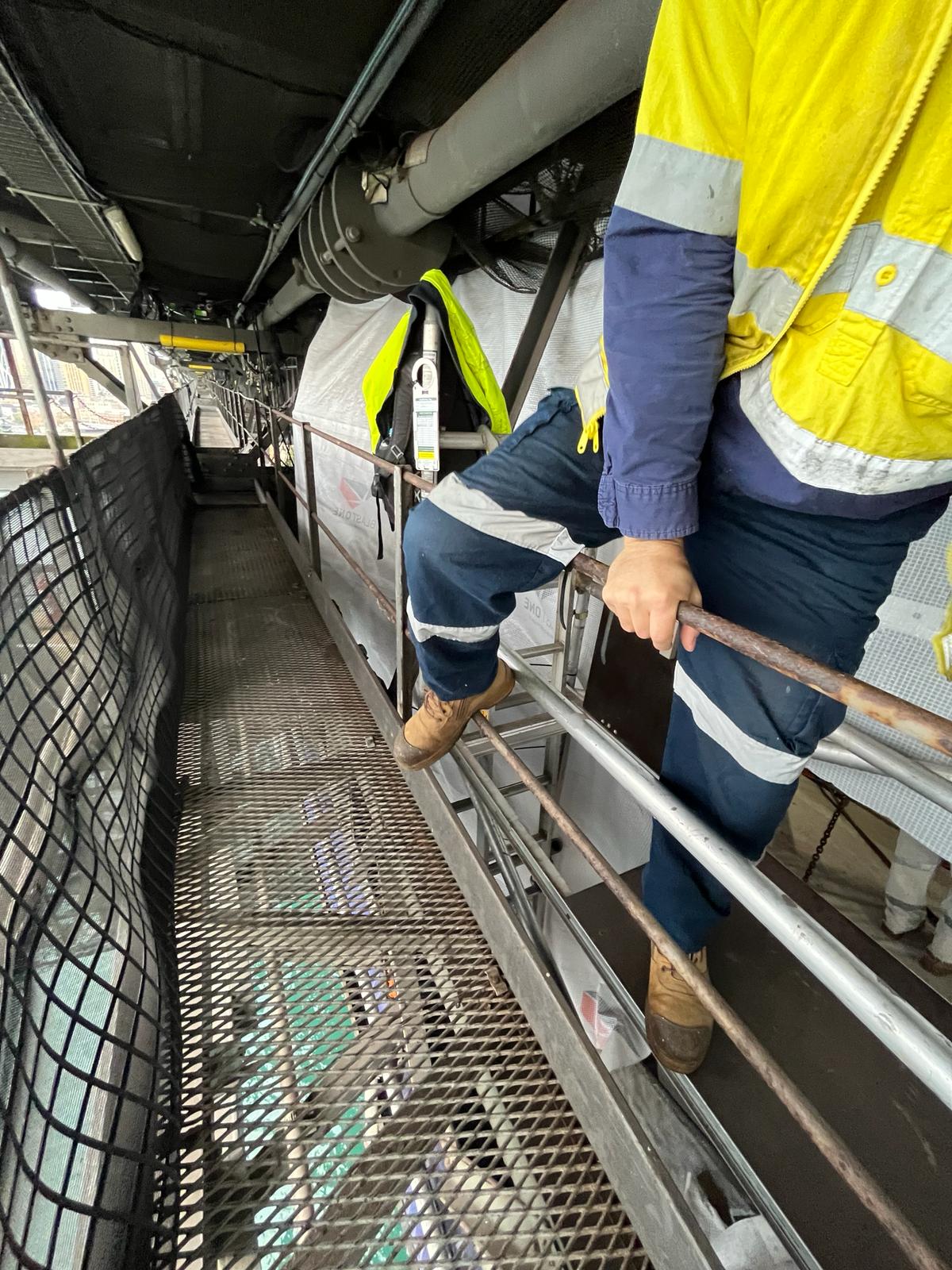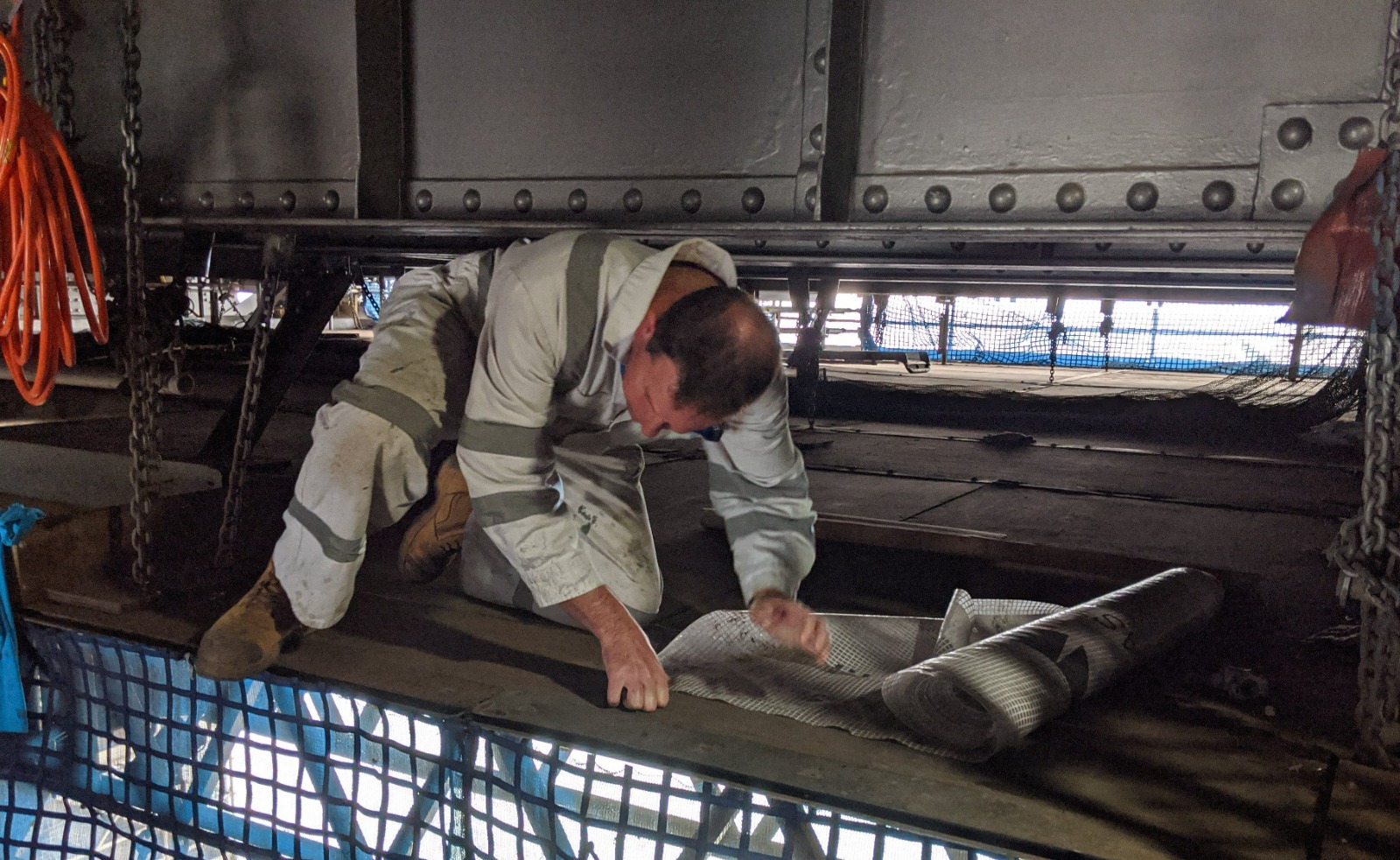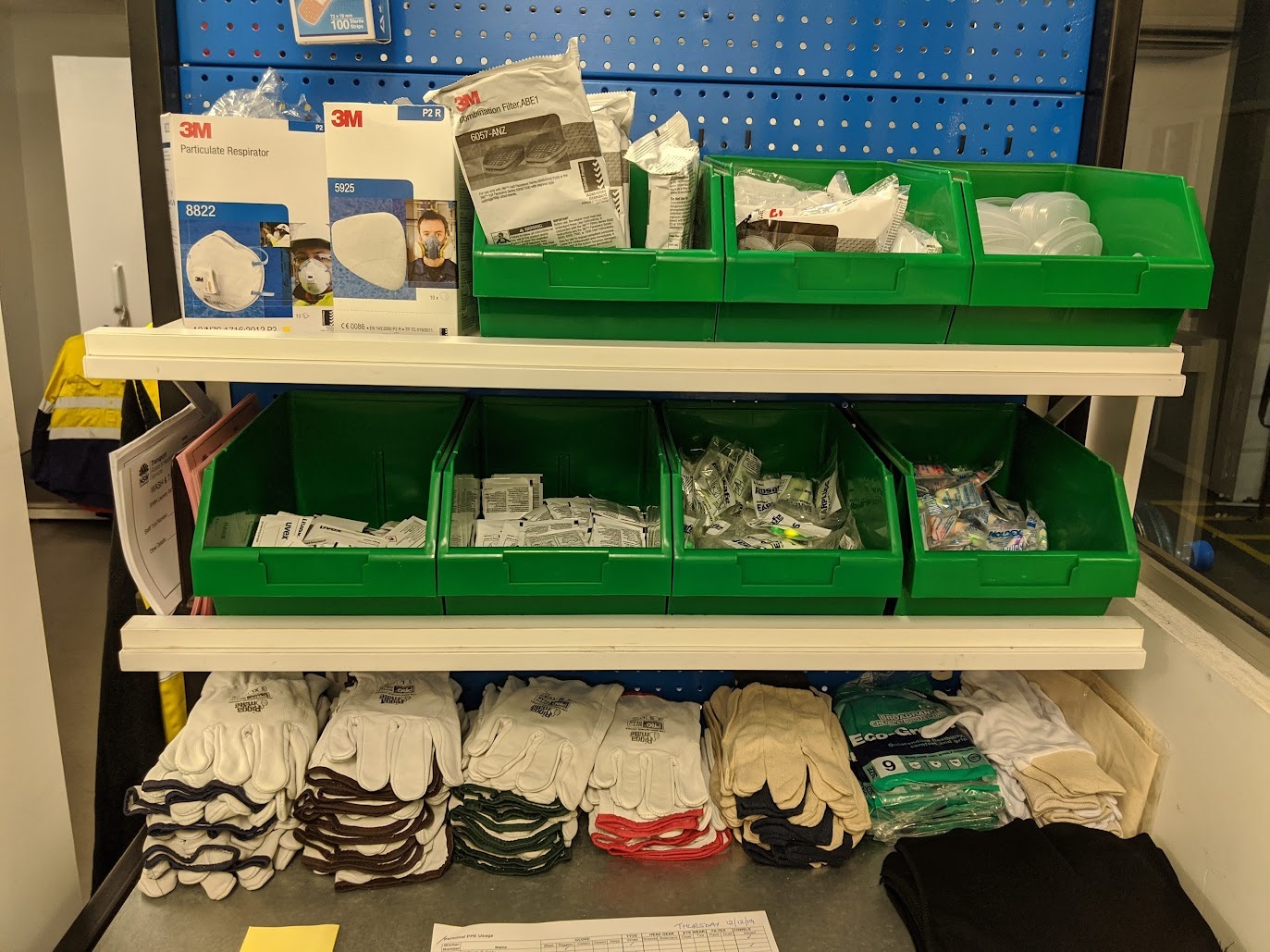SHB Painter - Job Demand Analysis
| Division | Road Maintenance and Resilience |
| Branch | Sydney Road Network Maintenance |
| Assessment locations | Sydney Harbour Bridge (2023) |
| Publication date | 19/08/2025 |
Role Summary
Painters are required to carry out all aspects of preparation, removal of old paint and painting work associated with the Sydney Harbour Bridge maintenance and refurbishment program.
Workers operate in teams and typically work 8 hour shifts on a day shift pattern, with an occasional requirement to work at night. Workers are at a high risk of being exposed to lead from the old paint, however appropriate PPE and controls are implemented to mitigate this risk.
Exposure To Critical Risks

Task Demand Summary
Task | Physical | Psychological | Environmental |
|---|---|---|---|
| Hand/Power tool cleaning - 20% |
|
|
|
| Blasting - 20% |
|
|
|
| Bridge painting - 20% |
|
|
|
| Containment and disassembly - 17% |
|
|
|
| Accessing work site - 10% |
|
|
|
| Preparatory work - 5% |
|
|
|
| Painting in paint room - 3% |
|
|
|
| Paint restocking - 3% |
|
|
|
| Admin/meetings - 2% |
|
|
|
| Overall Demand |
|
|
|
Whole Job Physical Demands Summary
| Physical demands | Frequency1 | Comments | ||||
|---|---|---|---|---|---|---|
1. Whole Body Movement | ||||||
| N | R | O | F | C | ||
| Sitting | X | Dependent on area to be cleaned/painted and space permitting. Workers are also typically seated during meetings and some trainings. | ||||
| Standing | X | Whilst cleaning, painting and setting up and disassembling containment areas. | ||||
| Walking | X | To navigate and access various worksites. | ||||
| Kneeling/squatting | X | To clean and paint surfaces close to/at ground height, or the underside of structures/beams. To access difficult to reach areas and crawl under beams/rails as low as 600mm. | ||||
| Climbing - Ladder | X | To access worksites and navigate through bridge. | ||||
| Climbing - Stairs | X | To access worksites and navigate in bridge. | ||||
2. Lower Back Movement | ||||||
| N | R | O | F | C | ||
| Bending forwards | X | To clean and paint difficult to reach areas on and navigate through fixed structures on the bridge. | ||||
| Stooping | X | |||||
| Bending backwards | X | Dependent on area to be cleaned and access to awkward areas in confined spaces. | ||||
| Twisting/side bend | X | To open/close gates whilst climbing up/down ladders and to access difficult to reach areas whilst painting and cleaning. | ||||
3. Neck Movement | ||||||
| N | R | O | F | C | ||
| Flexion | X | To maintain observation of surroundings whilst navigating through confined areas and whilst conducting work below head height. | ||||
| Extension | X | To clean and paint underside of structures when kneeling/laying underneath and maintain observation of work areas above head height. | ||||
| Rotation | X | To maintain observation of surroundings and passages when navigating through tight spaces on the bridge. Whilst cleaning, painting and conducting general physical tasks. | ||||
4. Upper Limb Movement | ||||||
| N | R | O | F | C | ||
| Wide grip | X | To use cleaning tools and paint cans and carry Monoflex plastic and plywood panels. To grasp onto railings, ladders and opening/closing gates and barriers. | ||||
| Fine grip | X | To secure containment/encapsulation materials, open and close latches for gates and barriers and secure PPE. | ||||
| Forward reach | X | To clean and paint hard to reach surfaces in constricted areas. Whilst setting up and handling containment/encapsulation materials and paint tins. To grasp onto railings, ladders. | ||||
| Overhead reach | X | When cleaning and painting the underside of beams/structures, to secure materials for containment above head height (walls and ceilings) and whilst climbing ladders. | ||||
| Side reach | X | To paint and clean hard to reach surfaces in constricted areas and grasp onto railings, ladders and opening/closing gates and barriers. | ||||
5. Weights and Forces | ||||||
| N | R | O | F | C | ||
| Floor (kg) | 20 | Rolls of Monoflex plastic 15kg, large paint tins max 35kg, tools and equipment, beams and brackets max 40kg (2 person lift). | ||||
| Bench (kg) | 20 | To hold power tool to surface being cleaned 5kg, paint cans/tins max 10kg, beams and brackets max 40kg (2 person lift). | ||||
| Shoulder (kg) | 20 | To support power tool to clean surfaces 3kg. To reach paint tins on top shelves 10kg. | ||||
| Above shoulder (kg) | 15 | To hold power tool to surface being cleaned 3kg. | ||||
| Carrying - Unilateral (kg) | 20 | To carry cleaning and painting tools 5kg, bags 5kg, paint cans 3-10kg. | ||||
| Carrying - Bilateral (kg) | 20 | Rolls of Monoflex plastic 15kg, large paint tins, beams and equipment (2 person lift for objects 20kg or more). | ||||
| Pushing (kg) | 25 | |||||
| Pulling (kg) | 20 | |||||
1: Never 0%; Rare 1 - 5%; Occasional 6 - 33%; Frequent 34 - 66%; Constant 67 - 100%
Whole Job Psychological Demands Summary
| Psychological demands | Frequency1 | Comments | ||||
|---|---|---|---|---|---|---|
1. Quantitative Demands | ||||||
| N | R | O | F | C | ||
| Fast work pace or significant time pressure | X | Workers are required to complete paint jobs of certain areas against set KPIs of square metre of works completed and maintain alignment with other maintenance teams. | ||||
| Low job autonomy/control | X | |||||
| Repetitive or monotonous tasks | X | Power tools, spray paint and paint brushes can only clean and paint a small surface area at a time in comparison to the large surface of the bridge. Additionally, the bridge structure is a repetitive environment and the nature of painting and cleaning is repetitive. | ||||
| Minimal training/education available | X | |||||
| Minimal tools/resources available | X | |||||
2. Cognitive Demands | ||||||
| N | R | O | F | C | ||
| Requirement to keep focus on multiple items at once | X | Workers must maintain awareness of surroundings and potential hazards to reduce risk of slips and falls. | ||||
| Requirement for sustained attention/vigilance | X | Workers must maintain awareness of surroundings for personal safety and to ensure painting meets required standards. | ||||
| Requirement to make difficult or quick decisions | X | |||||
3. Emotional Demands | ||||||
| N | R | O | F | C | ||
| Exposure likelihood to traumatic events | X | |||||
| Customer facing or interacting with the public | X | |||||
| Requirement to hide emotional feelings | X | |||||
| Requirement for working in isolation | X | |||||
1: Never 0%; Rare 1 - 5%; Occasional 6 - 33%; Frequent 34 - 66%; Constant 67 - 100%
Whole Job Environmental Demands Summary
| Environmental demands | Frequency1 | Comments | ||||
|---|---|---|---|---|---|---|
1. Physical Environment | ||||||
| N | R | O | F | C | ||
| Uneven, sloped or slippery terrain | X | Majority of work on bridge requires workers to navigate through and around a sloped environment with multiple trip hazards (bridge structure) and narrow and uneven walkways. | ||||
| Hand Arm Vibration | X | Power tools are handheld and vibrate when in operation. | ||||
| Whole Body Vibration | X | |||||
| Poor lighting | X | Certain job sites may have restricted lighting and workers are required to work some night shifts. Torches and lamps are supplied. | ||||
2. Elemental Exposure | ||||||
| N | R | O | F | C | ||
| Working in heat (>30C) | X | Dependent on seasonal changes. Workers conduct work in exposed environment with limited access to shelter, with direct sun exposure having large impact on heat experience. | ||||
| Working in cold (<10C) | X | Dependent on seasonal changes. Workers conduct work in exposed environment with windy conditions contributing to chill factor. | ||||
| Emergency weather conditions/events | X | |||||
3. Hazardous Exposure | ||||||
| N | R | O | F | C | ||
| Dust or other airborne contaminants | X | Dried paint and rust turn into dust particles once removed with power tools. Workers may experience exposure to lead particles from paint blasting. Workers are required to wear appropriate PPE. | ||||
| Noise | X | Noise from power tools and blasting equipment, ambient noise from equipment operating nearby and traffic passing by on bridge. Workers are required to wear appropriate PPE. | ||||
1: Never 0%; Rare 1 - 5%; Occasional 6 - 33%; Frequent 34 - 66%; Constant 67 - 100%
Task 1: Hand/Power tool cleaning - 20%
Physical demand | Psychological demand | Environmental demand |
|
|
|
Task Description
- Workers are required to clean off rust and old layers of lead-based paint (in encapsulated area) to prepare surface for painting.
- Depending on area of work and cleaning requirement, workers use 3 types of hand tools: needle scaler gun (metal rods pulse on surface to break down rust), whizzer wheel buffer or a CP (grinder with wire).
- Workers are are required to clean all surfaces that are to be painted and may involve working from step ladders, mini scaffolds, laying on the ground and/or crawling into confined areas.
- Workers are required to wear PPE (anti-vibration gloves) due to vibration exposure from tools.
- Workers self monitor tolerance of working position and vibration exposure and take breaks as needed.
- Once an encapsulated area is cleaned, waste is vacuumed and deposited in bins.
- Vacuum and bins are winched to and from the site by Riggers.
Key Demands
Kneeling/squatting (O), Climbing - Ladder (O), Climbing - Stairs (O), Twisting/side bend (O), Extension (O), Rotation (O), Wide grip (C), Overhead reach (O), Side reach (F), Fast work pace or significant time pressure (F), Requirement to keep focus on multiple items at once (O), Requirement for sustained attention/vigilance (O), Exposure likelihood to traumatic events (R), Uneven, sloped or slippery terrain (F), Hand Arm Vibration (F), Working in heat (>30C) (O), Working in cold (<10C) (O), Dust or other airborne contaminants (F), Noise (O)


Task 2: Blasting - 20%
Physical demand | Psychological demand | Environmental demand |
|
|
|
Task Description
- Where possible, workers will use pressurised sandblaster to blast off old paint and rust (space permitting) in a fully contained worksite (ie full encapsulation has been set up).
- Blaster is connected to large pipes (that are fed into encapsulated area). Workers are required to hold the hand held blaster pipe whilst bracing with upper body to counteract the push back pneumatic force (blaster emits 100 psi pressure).
- Certain job sites and bridge structures require workers to crawl into tight spaces, , bend down, lay on the floor or work in an overhead position. Pipe is held in various positions (from ground height, to waist to above head) to access and clean various surfaces and areas.
- Workers conduct task in presence of another worker to ensure safe operation of sandblaster, and task rotation as needed. Secondary worker also has access to dead man's switch for blasting pipe as a safety precaution.
- Vacuum for blasting waste connects to steel pipes to the vacuum unit in compound yard below, where waste is collected and transferred into waste drums for safe disposal.
Key Demands
Standing (C), Kneeling/squatting (F), Climbing - Ladder (O), Climbing - Stairs (O), Twisting/side bend (O), Extension (O), Rotation (O), Wide grip (C), Overhead reach (O), Side reach (O), Fast work pace or significant time pressure (F), Requirement to keep focus on multiple items at once (O), Requirement for sustained attention/vigilance (C), Requirement to make difficult or quick decisions (O), Exposure likelihood to traumatic events (R), Uneven, sloped or slippery terrain (C), Hand Arm Vibration (C), Working in heat (>30C) (O), Working in cold (<10C) (O), Dust or other airborne contaminants (F), Noise (C)

Task 3: Bridge painting - 20%
Physical demand | Psychological demand | Environmental demand |
|
|
|
Task Description
- Workers are required to apply 4 coats of paint for all surfaces of the bridge (2 primers, 1 intermediate and 1 top coat), as well as striping/cutting in. Each coat must dry for 24 hours before the next is applied.
- Workers only begin task once full encapsulation/containment has been established. The undercoat is applied by brush and rollers, and only the intermediate and top coat can be applied by spray machine(this is typically winched to the work area by Riggers during containment set up).
- Workers conduct task at variable heights and positions depending on surface/area to be painted.
- Areas with limited/restricted access may required bending, squatting, crawling or straddling steel structures.
- Workers push spray machine with low force, uneven surfaces require greater force to manoeuvre. Workers have variety of PPE to chose from for personal fit and comfort.
Key Demands
Standing (C), Kneeling/squatting (F), Climbing - Ladder (O), Climbing - Stairs (O), Twisting/side bend (O), Extension (F), Rotation (F), Wide grip (C), Overhead reach (O), Side reach (F), Fast work pace or significant time pressure (F), Requirement to keep focus on multiple items at once (O), Requirement for sustained attention/vigilance (O), Exposure likelihood to traumatic events (R), Uneven, sloped or slippery terrain (F), Working in heat (>30C) (O), Working in cold (<10C) (O), Noise (O)


Task 4: Containment and disassembly - 17%
Physical demand | Psychological demand | Environmental demand |
|
|
|
Task Description
- Painters are required to set up work area on various areas on/within the bridge with ply panels or full encapsulation before any paint cleaning begins (scaffolding is already set up by Riggers).
- Plywood (5-25 mm) is stored in pylon and are cut to required size before being transported to work area.
- Encapsulation must be set up before any paint blasting is conducted. Monoflex plastic used (2m x 45m and 4m x 25m, 15kg), this is carried to job sites by 2 workers.
- Containment and Disassembly may take up to 2 weeks each, this can vary depending on the complexity of the job site.
- Once containment is set up, workers are not required to wear harnesses and work may begin.
- Larger paint tins are usually transported to work area right after containment has been set up.
Key Demands
Standing (C), Kneeling/squatting (F), Climbing - Ladder (O), Climbing - Stairs (O), Twisting/side bend (O), Extension (F), Rotation (F), Wide grip (C), Forward reach (C), Overhead reach (F), Side reach (O), Fast work pace or significant time pressure (F), Requirement to keep focus on multiple items at once (O), Exposure likelihood to traumatic events (R), Uneven, sloped or slippery terrain (C), Working in heat (>30C) (O), Working in cold (<10C) (O), Noise (O)


Task 5: Accessing work site - 10%
Physical demand | Psychological demand | Environmental demand |
|
|
|
Task Description
- Workers typically access work site via catwalk under bridge from North or South pylon, distances travelled will vary depending on work site location. Workers may also drive light vehicles between north and south pylons depending on worksite location.
- Workers must navigate through tight spaces and are required to crawl, climb ladders and stairs, and step over beams/rails to access certain sites.
- Due to the fixed structures of the bridge, workers must maintain vigilance when accessing and navigating to and from work areas and be mindful of trip hazards at ground and obstacles at head height.
- Workers may be required to carry small paint pots (max 3kg) attached via lanyard.
- Personal tools and required PPE are either worn or carried by workers in backpack.
Key Demands
Walking (C), Kneeling/squatting (O), Climbing - Ladder (O), Climbing - Stairs (F), Twisting/side bend (O), Extension (O), Rotation (F), Overhead reach (O), Side reach (O), Requirement to keep focus on multiple items at once (F), Requirement for sustained attention/vigilance (F), Exposure likelihood to traumatic events (R), Uneven, sloped or slippery terrain (F), Working in heat (>30C) (F), Working in cold (<10C) (F), Dust or other airborne contaminants (O), Noise (O)


Task 6: Preparatory work - 5%
Physical demand | Psychological demand | Environmental demand |
|
|
|
Task Description
- Workers attend Toolbox Talk meetings prior to work starting for delegation of tasks and worksite location and discussion of hazards, risks and safe work practices.
- Workers are responsible for making sure their PPE meet standards and are appropriately worn for duration of work tasks.
Key Demands
Fine grip (C), Side reach (O)


Task 7: Painting in paint room - 3%
Physical demand | Psychological demand | Environmental demand |
|
|
|
Task Description
- Workers may undertake painting work of bridge parts in the paint room or in pylons. Objects painted and paints used may weigh anywhere from 2 - 40kg, two person lift for heavier and larger objects.
- Parts are cinched to and from the bridge by the Riggers and manually moved to and from truck by Painters
Key Demands
Standing (C), Walking (C), Kneeling/squatting (O), Twisting/side bend (F), Flexion (C), Extension (O), Rotation (O), Wide grip (C), Forward reach (C), Overhead reach (O), Side reach (F), Fast work pace or significant time pressure (O), Requirement for sustained attention/vigilance (O), Noise (O)


Task 8: Paint restocking - 3%
Physical demand | Psychological demand | Environmental demand |
|
|
|
Task Description
- Pallets of paint tins are delivered to the North and South Pylon, which are then transported to paint cabinets via a pallet jack.
- Workers then manually transfer the paint tins to shelves of varying height: 133 cm, 84 cm and 22 cm. Paint tins weight commonly ranges from 10-20 kg.
- Workers may also occasionally lift and carry glass metal flake tins which weigh 35kg.
Key Demands
Standing (C), Kneeling/squatting (O), Twisting/side bend (O), Extension (O), Rotation (O), Wide grip (C), Side reach (O), Fast work pace or significant time pressure (O), Noise (O)

Task 9: Admin/meetings - 2%
Physical demand | Psychological demand | Environmental demand |
|
|
|
Task Description
- Workers are required to maintain competency/training which may be completed by computer online or via face to face workshops.
Key Demands
Sitting (C), Rotation (O), Requirement for sustained attention/vigilance (O)
Key information
Demand rating is calculated via an algorithm based upon the relative weighting and frequency of the physical, environmental and psychological sub-tasks (e.g. squatting has a higher weighting than standing or walking).
This data may vary depending on production rates, changes in design or work organisation and staffing levels. This report was prepared by a trained and qualified health and safety professional within the TfNSW Occupational Health Team and reviewed by relevant Health and Safety, and operational stakeholders.
JDAs are periodically updated by the TfNSW Occupational Health Team or sooner where significant changes have been identified. For the latest version of this JDA, please always refer to this link rather than saving an offline copy.
For further information please contact occupational.health@transport.nsw.gov.au.

